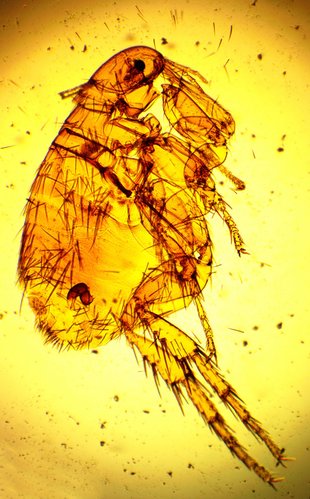We may earn revenue from the products available on this page and participate in affiliate programs. Learn More ›
Fleas are irritating—not only for pets but also for people. If you have fleas in the house, you can usually expect some itching, as well as unwelcome red bumps on the skin. But since pests carry disease, the problem can be more than merely annoying.
To get rid of fleas in the house, address the issue from a number of angles by cleaning your pets, your pets’ bedding, and the most flea-vulnerable surfaces around your home. Follow the steps outlined below in order to be successful.

How to Get Rid of Fleas in Your Home
STEP 1
Though they may be present in your carpeting, fleas prefer to live on a host—namely, your pet. So to completely get rid of fleas in the house, start with treating your dog or cat. Whether it’s a dip or tablet, there are many readily available products designed for the purpose.
Timing is key: Administer the treatment on the same day that you de-flea your house. In addition, dispose of the bedding your flea-ridden pet has been using. Place the bed in a trash bag, seal it, and take it outside immediately.
STEP 2
If your pet frequently sleeps on your bed, toss your own bedding directly into the washing machine. Next, get out your vacuum and throughly go over the entire house, paying special attention to areas under and behind the furniture. Also be sure to vacuum the furniture itself, as fleas often hide in upholstered sofas and chairs. In corners, use the vacuum nozzle attachment. Be aware that in the process of vacuuming, disturbed by the vibrating machine, fleas may actually emerge.
STEP 3
Very important: Once you’ve finished vacuuming, take the machine outside and empty it there. Seal the vacuum cleaner bag or its contents in a trash bag, seal it, and leave the bag safely outside your home.
STEP 4
Choose an insecticide that contains an insect growth regulator (ICR). These are chemicals (e.g., methoprene and pyriproxyfen) that prevent fleas from reproducing. Treat all soft surfaces, including carpeting, with the insecticide. Then keep pets and family members away from the treated areas for at least a few hours, until the insecticide has dried. Ventilate by opening doors and/or windows.
STEP 5
Some fleas may survive the insecticide. A week or two after treatment, you may find that fleas have returned. If so, vacuum the entire house once more, again taking care to empty the machine outside. You may also consider using flea traps to vanquish the remaining pests. Try mixing a bit of dish soap into a bowl of water; the mixture kills any fleas that fall in. Place bowls near the light sources that attract fleas. Likely targets are the lamps in the same room as your pet’s preferred sleeping area.
Preventing Future Infestations
It’s equally important to prevent fleas from returning. Here are a few tips to help you make your house—and your pets—inhospitable to a flea renaissance.
- If your pet seems itchy, put on a flea collar or administer a gel treatment. You must act fast, before the fleas migrate from your pet to the carpeting and furniture in your home. Watch Fluffy and Fido closely!
- Fleas dislike sun, so consider restricting your pets to those areas that receive a lot of light during the day. If impossible, keep in mind that there are flea-targeting insecticides formulated for use outdoors.
- Tiny and able to fit through the smallest cracks, fleas are an enemy of homes with many air leaks. Caulk as many holes and gaps in your house as you can.
- Consider consulting one of the best pest control companies, such as Orkin or Terminix, to understand your options for eradicating or preventing a flea infestation.


